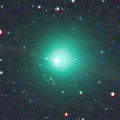
|
Now it is very bright as 7.9 mag (Feb. 21, Osamu Miyazaki). It will pass the perihelion on Mar. 10. In the Northern Hemisphere, it stays observable until late February. In the Southern Hemisphere, it will appear in the morning sky in late March at 8 mag, then it stays observable while the comet will be fading.
Date(TT) R.A. (2000) Decl. Delta r Elong. m1 Best Time(A, h)
Feb. 25 0 8.58 7 1.0 0.899 0.480 28 7.8 19:15 ( 91, 11)
Mar. 4 0 3.19 3 45.2 0.751 0.374 19 6.7 19:21 ( 94, 0)
|
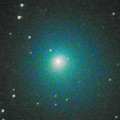
|
Now it is 10.2 mag (Feb. 24, Piotr Guzik). Brightening rapidly. It will approach to the earth down to 0.14 a.u. from March to April. It is expected to brighten up to 5-6 mag. It may brighten furthermore in outburst. It is observable in excellent condition in the Northern Hemisphere. In the Southern Hemisphere, it will not be observable for about one month around the highlight. But it stays observable in good condition except for that period.
Date(TT) R.A. (2000) Decl. Delta r Elong. m1 Best Time(A, h)
Feb. 25 9 40.23 24 24.6 0.240 1.218 160 10.1 23:19 ( 0, 80)
Mar. 4 9 48.68 31 15.0 0.205 1.174 150 8.9 23:00 ( 0, 87)
|
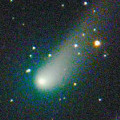
|
Now it is 10.3 mag (Feb. 24, Piotr Guzik). It is expected to brighten up to 7 mag in summer. Recently it is fainter than predicted. In the Northern Hemisphere, it stays observable in good condition until the highlight while the comet will be brightening. In the Southern Hemisphere, it stays extremely low for a while.
Date(TT) R.A. (2000) Decl. Delta r Elong. m1 Best Time(A, h)
Feb. 25 16 12.06 45 51.1 1.752 2.158 100 9.3 5:10 (213, 77)
Mar. 4 16 19.98 46 17.4 1.668 2.102 101 9.0 5:02 (205, 77)
|

|
Now it is 10.9 mag (Feb. 23, Chris Wyatt). It is expected to brighten up to 7 mag in spring. But recently it is fainter than predicted. It locates somewhat low at the high light.
Date(TT) R.A. (2000) Decl. Delta r Elong. m1 Best Time(A, h)
Feb. 25 17 49.30 -23 46.4 1.644 1.582 68 9.6 5:10 (325, 23)
Mar. 4 18 17.82 -23 17.2 1.535 1.504 69 9.2 5:02 (323, 22)
|
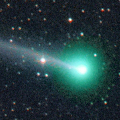
|
It approached to the earth down to 0.08 a.u. in mid February, and brightened up to 6.5 mag (Feb. 10, Danil Sidorko). Now it is fading rapidly. Now it is 8.4 mag (Feb. 24, Piotr Guzik). It will be fainter than 10 mag in late February.
Date(TT) R.A. (2000) Decl. Delta r Elong. m1 Best Time(A, h)
Feb. 25 11 37.41 28 32.7 0.200 1.175 155 9.6 1:21 ( 0, 84)
Mar. 4 11 2.86 25 33.6 0.293 1.272 160 10.9 0:18 ( 0, 81)
|

|
Bright new fragment BT was discovered on Feb. 10. Now the fragment BT is very bright as 11.9 mag (Feb. 23, Chris Wyatt). The primary component is 13.4 mag (Jan. 28, Piotr Guzik). It will be unobservable soon in the Northern Hemisphere. In the Southern Hemisphere, it stays observable for a long time after this.
Date(TT) R.A. (2000) Decl. Delta r Elong. m1 Best Time(A, h)
Feb. 25 19 22.47 -21 9.9 1.380 1.013 47 11.9 5:10 (306, 11)
Mar. 4 19 59.68 -20 56.4 1.385 0.990 45 11.9 5:02 (303, 8)
|
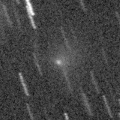
|
Brightening very rapidly. Now it is bright as 13.5 mag (Feb. 25, Alan Hale). Small comet, but it approaches to the sun down to 0.9 a.u., and to the earth down to 0.5 a.u., and it will brighten up to 12.5 mag in March. It is observable in excellent condition in the Northern Hemisphere. In the Southern Hemisphere, it stays observable only until mid February. Juan Jose Gonzalez reported it is very bright as 10.7 mag on Feb. 24.
Date(TT) R.A. (2000) Decl. Delta r Elong. m1 Best Time(A, h)
Feb. 25 2 18.38 25 53.8 0.654 0.929 65 13.3 19:15 ( 93, 47)
Mar. 4 2 30.23 33 55.1 0.615 0.912 64 12.8 19:21 (106, 46)
|
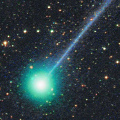
|
It brightened rapidly up to 6.8 mag (Jan. 6, Katsumi Yoshimoto). It approached to the sun down to 0.3 a.u. on Jan. 14. Michael Mattiazzo reported that the comet was visible in the SWAN images from Jan. 19 to Jan. 29 while it faded from 5 mag to 7 mag. It is not observable after this in the Northern Hemisphere. In the Southern Hemisphere, it is appearing in the extremely low sky in the evening.
Date(TT) R.A. (2000) Decl. Delta r Elong. m1 Best Time(A, h)
Feb. 25 23 23.18 -30 29.1 1.921 1.098 24 12.8 19:15 ( 66,-19)
Mar. 4 23 49.98 -28 44.6 2.054 1.232 25 13.5 19:21 ( 68,-19)
|

|
It has not been observed yet in this apparition. The condition of this apparition is worst. It will brighten up to 10 mag in spring, but not observable at all.
Date(TT) R.A. (2000) Decl. Delta r Elong. m1 Best Time(A, h)
Feb. 25 22 43.98 -1 17.2 2.267 1.296 8 13.7 19:15 ( 97,-11)
Mar. 4 23 7.83 0 32.9 2.223 1.246 7 13.3 19:21 (100,-12)
|

|
Now it is not observable. It will appear in the morning sky in March.
Date(TT) R.A. (2000) Decl. Delta r Elong. m1 Best Time(A, h)
Feb. 25 20 55.30 -18 10.4 6.743 5.863 25 13.9 5:10 (290, -4)
Mar. 4 21 0.65 -17 44.2 6.690 5.861 30 13.9 5:02 (291, -1)
|

|
Now it is 13.7 mag (Jan. 24, Juan Jose Gonzalez). It is observable in excellent condition in the Northern Hemisphere. It stays low in the Southern Hemisphere.
Date(TT) R.A. (2000) Decl. Delta r Elong. m1 Best Time(A, h)
Feb. 25 12 0.08 31 38.7 1.597 2.502 149 14.2 1:42 ( 0, 87)
Mar. 4 11 55.68 32 8.1 1.602 2.516 151 14.2 1:10 ( 0, 87)
|
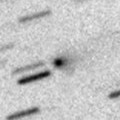
|
Now it is 16.1 mag (Feb. 23, Thomas Lehmann). It will brighten up to 10 mag in summer, and it will be observable in excellent condition in the Southern Hemisphere. It locates low in the Northern Hemisphere.
Date(TT) R.A. (2000) Decl. Delta r Elong. m1 Best Time(A, h)
Feb. 25 15 31.32 -11 30.5 1.486 1.961 102 14.6 5:10 (359, 43)
Mar. 4 15 42.06 -12 16.9 1.385 1.926 107 14.3 4:55 ( 0, 43)
|

|
Now it is bright as 14.4 mag (Jan. 14, Thomas Lehmann). It will be observable at 11 mag for a long time from 2017 to 2018. Now it is observable in excellent condition in the Southern Hemisphere. But it stays low for a while in the Northern Hemisphere.
Date(TT) R.A. (2000) Decl. Delta r Elong. m1 Best Time(A, h)
Feb. 25 2 53.18 -26 12.1 5.394 5.035 63 14.7 19:15 ( 38, 18)
Mar. 4 2 56.28 -24 48.2 5.411 4.983 59 14.6 19:21 ( 45, 15)
|
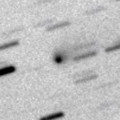
|
Now it is 15.7 mag (Jan. 4, T. Ikemura, H. Sato). It will brighten up to 14 mag from spring to summer. It locates somewhat low in the Northern Hemisphere. The perihelion distance increased from 2.4 a.u. to 2.9 a.u. in this apparition. So it will not be bright as before.
Date(TT) R.A. (2000) Decl. Delta r Elong. m1 Best Time(A, h)
Feb. 25 16 13.58 -18 29.1 2.942 3.128 91 15.1 5:10 (347, 35)
Mar. 4 16 18.84 -18 50.7 2.832 3.116 97 15.0 5:02 (351, 36)
|

|
Now it is 14.3 mag (Dec. 31, Jakub Cerny). It will be unobservable in March.
Date(TT) R.A. (2000) Decl. Delta r Elong. m1 Best Time(A, h)
Feb. 25 1 19.49 -1 22.7 5.959 5.269 42 15.1 19:15 ( 73, 20)
Mar. 4 1 25.32 -0 52.3 6.046 5.288 37 15.1 19:21 ( 78, 15)
|

|
Now it is 15.3 mag (Jan. 31, Alexander Baransky). It stays 15 mag until spring. But it is already unobservable in the Southern Hemisphere. It will be getting lower gradually after this also in the Northern Hemisphere.
Date(TT) R.A. (2000) Decl. Delta r Elong. m1 Best Time(A, h)
Feb. 25 1 19.08 18 8.9 2.170 1.701 49 15.1 19:15 ( 91, 31)
Mar. 4 1 38.06 19 58.0 2.209 1.700 47 15.2 19:21 ( 95, 29)
|
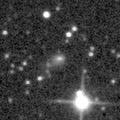
|
Now it is 16.7 mag (Nov. 3, Kunihiro Shima). It will be observable at 13 mag for a long time from 2017 to 2018. It is appearing in the morning sky again.
Date(TT) R.A. (2000) Decl. Delta r Elong. m1 Best Time(A, h)
Feb. 25 19 9.29 -0 7.7 5.417 4.860 51 15.3 5:10 (292, 28)
Mar. 4 19 10.63 0 51.6 5.285 4.823 57 15.2 5:02 (295, 32)
|

|
Now it is 15.6 mag (Jan. 31, Alexander Baransky). It will brighten up to 12-13 mag and will be observable in good condition in summer. It ia already unobservable in the Southern Hemisphere. It will be unobservable soon also in the Northern Hemisphere. It will appear in the morning sky in May.
Date(TT) R.A. (2000) Decl. Delta r Elong. m1 Best Time(A, h)
Feb. 25 0 9.03 13 21.1 4.101 3.314 32 15.3 19:15 ( 97, 14)
Mar. 4 0 10.18 13 17.9 4.131 3.274 26 15.3 19:21 (101, 8)
|

|
It brightened up to 11 mag from spring to summer in 2016. It is appearing in the morning sky again. It will be observable at 16-17 mag in good condition from spring to summer.
Date(TT) R.A. (2000) Decl. Delta r Elong. m1 Best Time(A, h)
Feb. 25 19 19.02 -20 19.1 3.096 2.540 47 15.7 5:10 (306, 12)
Mar. 4 19 29.78 -19 57.6 3.065 2.582 52 15.8 5:02 (307, 14)
|

|
Now it is 15.6 mag (Jan. 9, J. L. Martin). It stays observable at 16 mag in good condition until spring. It locates low in the Southern Hemisphere.
Date(TT) R.A. (2000) Decl. Delta r Elong. m1 Best Time(A, h)
Feb. 25 6 43.26 27 44.7 3.084 3.719 123 15.9 20:22 ( 0, 83)
Mar. 4 6 43.24 27 43.6 3.167 3.712 116 15.9 19:54 ( 0, 83)
|

|
Now it is 15.6 mag (Jan. 26, Alexander Baransky). It stays 16-17 mag for a long time from 2016 to 2019. It stays near by the equator.
Date(TT) R.A. (2000) Decl. Delta r Elong. m1 Best Time(A, h)
Feb. 25 9 9.57 3 42.8 8.691 9.620 158 15.9 22:47 ( 0, 59)
Mar. 4 9 8.20 4 2.7 8.726 9.616 152 15.9 22:19 ( 0, 59)
|
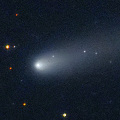
|
It brightened up to 11-12 mag from summer to autumn. Now it is fading. But it is bright as 13.6 mag still now (Jan. 24, Seiichi Yoshida).
Date(TT) R.A. (2000) Decl. Delta r Elong. m1 Best Time(A, h)
Feb. 25 12 19.05 -27 34.7 1.544 2.351 135 16.0 2:01 ( 0, 27)
Mar. 4 12 12.72 -27 12.6 1.540 2.399 141 16.2 1:27 ( 0, 28)
|

|
It was observed at 16 mag from spring to summer in 2016. It will be observable at 16 mag also in 2017 from winter to spring.
Date(TT) R.A. (2000) Decl. Delta r Elong. m1 Best Time(A, h)
Feb. 25 17 52.93 -3 27.6 3.513 3.301 69 16.1 5:10 (311, 39)
Mar. 4 17 59.87 -1 48.6 3.440 3.317 74 16.1 5:02 (313, 42)
|

|
It stayed bright 12 mag for a long time from autum in 2015 to summer in 2016. Now it is fading. It has already faded dwon to 15.6 mag (Jan. 6, Hiroshi Abe).
Date(TT) R.A. (2000) Decl. Delta r Elong. m1 Best Time(A, h)
Feb. 25 17 24.00 -6 32.5 4.529 4.401 76 16.3 5:10 (321, 40)
Mar. 4 17 24.84 -6 55.1 4.466 4.451 82 16.3 5:02 (327, 42)
|
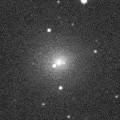
|
It brightened up to 11-12 mag in autumn. Now it is fading. But it is bright as 13.9 mag still now (Jan. 24, Seiichi Yoshida).
Date(TT) R.A. (2000) Decl. Delta r Elong. m1 Best Time(A, h)
Feb. 25 13 55.03 -16 49.1 1.641 2.339 123 16.3 3:36 ( 0, 38)
Mar. 4 13 52.77 -16 40.3 1.617 2.388 131 16.5 3:06 ( 0, 38)
|

|
It has not been observed yet in this apparition. It will brighten up to 12 mag in summer. It will be observable in excellent condition in the Southern Hemisphere. It locates somewhat low in the Northern Hemisphere.
Date(TT) R.A. (2000) Decl. Delta r Elong. m1 Best Time(A, h)
Feb. 25 17 36.16 -32 32.6 2.647 2.518 71 16.6 5:10 (333, 16)
Mar. 4 17 48.76 -32 47.9 2.537 2.490 75 16.4 5:02 (334, 17)
|

|
Now it is 16.8 mag (Jan. 6, D. Buczynski). It is expected to brighten up to 9 mag in summer in 2018. In the Northern Hemisphere, it stays observable until 2018 summer while the comet will be brightening. In the Southern Hemisphere, it is hardly observable in 2017, but it will be observable in good condition in 2018.
Date(TT) R.A. (2000) Decl. Delta r Elong. m1 Best Time(A, h)
Feb. 25 18 58.96 45 55.5 6.016 5.801 72 16.5 5:10 (238, 50)
Mar. 4 19 2.82 46 22.9 5.934 5.746 74 16.5 5:02 (237, 52)
|

|
Now it is 16.5 mag (Jan. 26, Alexander Baransky). It stays 16 mag for a long time from 2017 to 2018.
Date(TT) R.A. (2000) Decl. Delta r Elong. m1 Best Time(A, h)
Feb. 25 8 45.62 -2 5.3 4.809 5.696 151 16.5 22:23 ( 0, 53)
Mar. 4 8 39.89 -0 45.1 4.840 5.678 144 16.5 21:50 ( 0, 54)
|

|
Now it is 16.5 mag (Dec. 29, Sandor Szabo). It will brighten up to 15 mag and will be observable in good condition from autum to winter in 2017. In the Northern Hemisphere, it stays observable in good condition for a long time while the comet will be brightening. It is not observable until summer in the Southern Hemisphere.
Date(TT) R.A. (2000) Decl. Delta r Elong. m1 Best Time(A, h)
Feb. 25 1 54.35 38 12.8 5.218 4.912 66 16.5 19:15 (111, 46)
Mar. 4 1 56.06 37 18.8 5.300 4.884 60 16.5 19:21 (112, 40)
|

|
Now it is 16.5 mag (Dec. 26, A. Diepvens). It stays 16.5 mag from 2016 to 2017. In the Northern Hemisphere, it stays observable in good condition for a long time. In the Southern Hemisphere, it will never be observable again.
Date(TT) R.A. (2000) Decl. Delta r Elong. m1 Best Time(A, h)
Feb. 25 18 37.32 43 26.4 6.452 6.266 74 16.6 5:10 (242, 53)
Mar. 4 18 42.36 44 47.9 6.422 6.271 76 16.6 5:02 (240, 56)
|

|
It brightened up to 6 mag from autumn in 2015 to early 2016. Now it is fading. It has already faded down to 16.0 mag (Jan. 1, Yuji Ohshima). It is observable in good condition in the Northern Hemisphere. It is not observable after this in the Southern Hemisphere.
Date(TT) R.A. (2000) Decl. Delta r Elong. m1 Best Time(A, h)
Feb. 25 2 55.82 45 8.3 6.002 5.913 80 16.6 19:15 (121, 58)
Mar. 4 2 57.62 44 38.5 6.176 5.978 73 16.7 19:21 (120, 52)
|

|
It has not been observed since last April. Now it is fading. But it must be bright as 17 mag still now.
Date(TT) R.A. (2000) Decl. Delta r Elong. m1 Best Time(A, h)
Feb. 25 16 57.17 -20 28.4 2.775 2.797 81 16.7 5:10 (336, 31)
Mar. 4 17 2.22 -20 13.4 2.746 2.869 86 16.8 5:02 (339, 32)
|
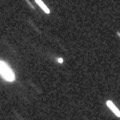
|
Now it is 17.1 mag (Jan. 9, ATLAS-HKO, Haleakala). It brightened rapidly, and became brighter than originally expected. It stays 17 mag until 2017. In the Northern Hemisphere, it stays observable in excellent condition for a long time. It is not observable in the Southern Hemisphere.
Date(TT) R.A. (2000) Decl. Delta r Elong. m1 Best Time(A, h)
Feb. 25 13 7.33 60 53.5 6.829 7.387 120 16.9 2:49 (180, 64)
Mar. 4 12 57.98 61 14.1 6.836 7.395 120 16.9 2:12 (180, 64)
|

|
It brightened up to 15 mag in early 2016. Now it is fading. It has already faded down to 16.3 mag (Dec. 30, Sandor Szabo). In the Northern Hemisphere, it stays observable in good condition for a long time until 2017 autumn when the comet will be fainter than 18 mag. It will never be observable after this in the Southern Hemisphere.
Date(TT) R.A. (2000) Decl. Delta r Elong. m1 Best Time(A, h)
Feb. 25 15 34.49 70 21.1 6.098 6.402 103 17.0 5:10 (181, 55)
Mar. 4 15 30.93 70 52.9 6.131 6.431 103 17.0 4:43 (180, 54)
|
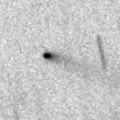
|
Now it is 16.9 mag (Feb. 1, Alexander Baransky). It was observed at 17 mag last winter. It will be observable at 17 mag again next winter. It is observable in good condition in the Northern Hemisphere. But it locates low in the Southern Hemisphere.
Date(TT) R.A. (2000) Decl. Delta r Elong. m1 Best Time(A, h)
Feb. 25 11 16.42 36 28.4 3.235 4.128 150 17.2 0:58 (180, 89)
Mar. 4 11 12.69 37 56.4 3.279 4.156 148 17.3 0:27 (180, 87)
|

|
It will pass the perihelion in 2019. However, it has not been brightening since the discovery in 2010. Now it is 17.1 mag (Jan. 4, T. Ikemura, H. Sato). It stays observable in excellent condition in the Northern Hemisphere. It is not observable in the Southern Hemisphere.
Date(TT) R.A. (2000) Decl. Delta r Elong. m1 Best Time(A, h)
Feb. 25 3 44.11 60 20.8 9.383 9.471 92 17.2 19:15 (153, 59)
Mar. 4 3 46.17 60 10.9 9.455 9.453 86 17.3 19:21 (149, 56)
|
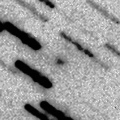
|
Now it is 17.2 mag (Dec. 30, A. Diepvens). In the Northern Hemisphere, it is observable at 17-18 mag until March. It is not observable in the Southern Hemisphere.
Date(TT) R.A. (2000) Decl. Delta r Elong. m1 Best Time(A, h)
Feb. 25 18 3.81 74 5.8 1.731 2.035 92 17.3 5:10 (194, 47)
Mar. 4 17 20.81 79 0.5 1.722 2.066 95 17.3 5:02 (186, 45)
|

|
Now it is 16.1 mag (Dec. 30, Yuji Ohshima). It is observable in excellent condition in the Northern Hemisphere. It locates low in the Southern Hemisphere. It will be fainter than 18 mag in March.
Date(TT) R.A. (2000) Decl. Delta r Elong. m1 Best Time(A, h)
Feb. 25 6 42.16 33 25.5 2.855 3.482 122 17.3 20:21 ( 0, 88)
Mar. 4 6 43.74 33 1.7 2.950 3.494 115 17.4 19:55 ( 0, 88)
|

|
Now it is 18.2 mag (Dec. 6, T. Ikemura, H. Sato). It was expected to be observable at 17 mag in good condition in winter. But actually, it is fainter than this ephemeris.
Date(TT) R.A. (2000) Decl. Delta r Elong. m1 Best Time(A, h)
Feb. 25 12 46.51 1 11.3 1.844 2.720 145 17.4 2:28 ( 0, 56)
Mar. 4 12 42.84 2 2.8 1.826 2.750 153 17.4 1:57 ( 0, 57)
|
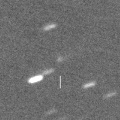
|
Now it is 17.4 mag (Jan. 25, Alexander Baransky). It is observable at 17.5 mag in good condition from winter to spring.
Date(TT) R.A. (2000) Decl. Delta r Elong. m1 Best Time(A, h)
Feb. 25 15 4.23 -11 16.5 1.858 2.377 109 17.5 4:45 ( 0, 44)
Mar. 4 15 7.91 -11 29.6 1.794 2.394 115 17.5 4:21 ( 0, 43)
|
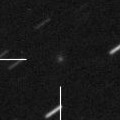
|
Now it is 17.3 mag (Jan. 8, CAO, San Pedro de Atacama). It is observable at 17.5 mag in good condition in this winter in the Southern Hemisphere.
Date(TT) R.A. (2000) Decl. Delta r Elong. m1 Best Time(A, h)
Feb. 25 5 49.65 -33 36.3 3.559 3.865 100 17.6 19:28 ( 0, 22)
Mar. 4 5 47.07 -30 44.4 3.622 3.869 96 17.7 19:21 ( 6, 24)
|

|
It brightened up to 8-9 mag from winter to spring in 2016. Now it is fading. It has already faded down to 17.1 mag (Dec. 6, T. Ikemura, H. Sato).
Date(TT) R.A. (2000) Decl. Delta r Elong. m1 Best Time(A, h)
Feb. 25 12 57.74 -15 40.7 4.324 5.086 136 17.7 2:39 ( 0, 39)
Mar. 4 12 52.56 -15 55.6 4.308 5.143 143 17.8 2:07 ( 0, 39)
|
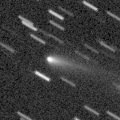
|
It brightened up to 14.6 mag from autum to winter (Dec. 2, Kunihiro Shima). Now it is fading. It has already faded down to 16.9 mag (Jan. 31, Alexander Baransky). It will be fainter than 18 mag in March.
Date(TT) R.A. (2000) Decl. Delta r Elong. m1 Best Time(A, h)
Feb. 25 4 29.46 30 30.5 2.769 3.005 94 17.7 19:15 ( 77, 75)
Mar. 4 4 36.91 30 24.3 2.890 3.033 88 17.9 19:21 ( 83, 70)
|
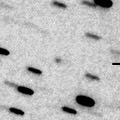
|
Now it is 18.9 mag (Dec. 27, K. Hills). It is observable at 18 mag in good condition from January to March.
Date(TT) R.A. (2000) Decl. Delta r Elong. m1 Best Time(A, h)
Feb. 25 10 32.54 -8 29.0 2.274 3.231 162 17.9 0:14 ( 0, 46)
Mar. 4 10 27.91 -8 24.0 2.289 3.251 163 17.9 23:38 ( 0, 47)
|
|
![]()
 29P/Schwassmann-Wachmann 1
29P/Schwassmann-Wachmann 1 315P/2013 V6 ( LONEOS )
315P/2013 V6 ( LONEOS ) 71P/Clark
71P/Clark C/2016 R2 ( PanSTARRS )
C/2016 R2 ( PanSTARRS ) 65P/Gunn
65P/Gunn C/2011 KP36 ( Spacewatch )
C/2011 KP36 ( Spacewatch ) 93P/Lovas 1
93P/Lovas 1 C/2015 O1 ( PanSTARRS )
C/2015 O1 ( PanSTARRS ) C/2015 VL62 ( Lemmon-Yeung-PanSTARRS )
C/2015 VL62 ( Lemmon-Yeung-PanSTARRS ) 81P/Wild 2
81P/Wild 2 74P/Smirnova-Chernykh
74P/Smirnova-Chernykh C/2014 B1 ( Schwartz )
C/2014 B1 ( Schwartz ) 43P/Wolf-Harrington
43P/Wolf-Harrington C/2016 B1 ( NEOWISE )
C/2016 B1 ( NEOWISE ) C/2014 W2 ( PanSTARRS )
C/2014 W2 ( PanSTARRS ) 144P/Kushida
144P/Kushida 213P/Van Ness
213P/Van Ness C/2016 M1 ( PanSTARRS )
C/2016 M1 ( PanSTARRS ) C/2016 A1 ( PanSTARRS )
C/2016 A1 ( PanSTARRS ) C/2015 V1 ( PanSTARRS )
C/2015 V1 ( PanSTARRS ) C/2014 OE4 ( PanSTARRS )
C/2014 OE4 ( PanSTARRS ) C/2013 US10 ( Catalina )
C/2013 US10 ( Catalina ) C/2015 TQ209 ( LINEAR )
C/2015 TQ209 ( LINEAR ) C/2014 R3 ( PanSTARRS )
C/2014 R3 ( PanSTARRS ) C/2013 V4 ( Catalina )
C/2013 V4 ( Catalina ) C/2015 X7 ( ATLAS )
C/2015 X7 ( ATLAS ) C/2010 U3 ( Boattini )
C/2010 U3 ( Boattini ) C/2016 T2 ( Matheny )
C/2016 T2 ( Matheny ) P/2015 TP200 ( LINEAR )
P/2015 TP200 ( LINEAR ) 118P/Shoemaker-Levy 4
118P/Shoemaker-Levy 4 94P/Russell 4
94P/Russell 4 C/2017 A3 ( Elenin )
C/2017 A3 ( Elenin ) C/2014 S2 ( PanSTARRS )
C/2014 S2 ( PanSTARRS ) 56P/Slaughter-Burnham
56P/Slaughter-Burnham 330P/2015 U1 ( Catalina )
330P/2015 U1 ( Catalina )![]()









































